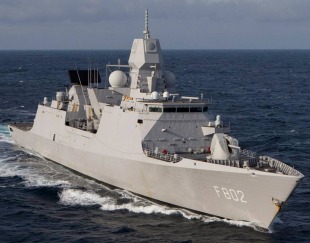Ракетний фрегат HNLMS De Zeven Provinciën (F802)
Основна інформація
Головні розміри
Машина
- 2 * Wärtsilä 16 V26 marine diesel engines, 5.1 MW (6,800 hp) each
- 2 * Rolls-Royce Marine Spey SM 1C gas turbines, 19.5 MW (26,100 hp) each
- 2 * propeller shafts, 5-bladed controllable pitch propellers
Персонал
Бойові сили та засоби
- Thales Nederland SMART-L long-range air and surface surveillance radar
- Thales Nederland APAR air and surface search, tracking and guidance radar (I band)
- DECCA NAV navigation radar
- Thales Nederland Scout (Low Probability of Intercept)surface search/navigation radar
- Thales Nederland Sirius IRST long-range infrared surveillance and tracking system
- Thales Nederland Mirador optical surveillance and tracking system
- Atlas Elektronik DSQS-24C hull-mounted sonar
- MK XII IFF system
- Guns:
- 1 * Oto Melara 127 mm/54 dual-purpose gun
- 2-4 * Browning M2 12.7mm machine guns
- 4-6 * FN MAG 7.62mm machine guns
- 1-2 * Goalkeeper CIWS
- Missiles:
- 40-cell Mk.41 vertical launch system
- 32 * SM-2 IIIA surface-to-air missiles
- 32 * Evolved Sea Sparrow Missile (quadpacked)
- 8 * Harpoon anti-ship missiles
- 2 * twin MK32 Mod 9 torpedo launchers with Raytheon MK46 Mod 5 torpedoes
- 1 * NH-90 helicopter
HNLMS De Zeven Provinciën (F802) is the first ship of the De Zeven Provinciën-class air defence and command frigates in service with the Royal Netherlands Navy (RNLN). There are three other ships in this class, HNLMS Tromp (F803), HNLMS De Ruyter (F804), and HNLMS Evertsen (F805).
De Zeven Provinciën is the eighth ship in the Royal Netherlands Navy to carry this name. The name refers to the original seven Dutch provinces which together formed the Union of Utrecht.
She was built by Damen Schelde Naval Shipbuilding (formerly the Koninklijke Schelde Groep) in Vlissingen. Her design incorporates stealth technology, as well as advanced radars of Dutch design such as SMART-L and APAR.
De Zeven Provinciën carries the Evolved Sea Sparrow Missile (ESSM) and the SM-2 Block IIIA missile systems. The primary sensor used to guide these missile systems is APAR.
In November 2003, approximately 200 nautical miles (370 km; 230 mi) from the Azores, De Zeven Provinciën conducted her first live firings of these missile systems. The firings involved a single ESSM and a single SM-2. These firings were particularly significant in that they were the first ever live firings involving a full-size ship-borne Active Electronically Scanned Array (i.e., APAR) guiding missiles using the Interrupted Continuous Wave Illumination (ICWI) technique in an operational environment.
Further live firings were performed by De Zeven Provinciën in March 2005, again in the Atlantic Ocean approximately 180 nautical miles (330 km; 210 mi) west of the Azores. The tests involved three live-firing events including firing a single SM-2 at an Iris target drone at long range, a single ESSM at an Iris target drone, and a two-salvo launch (with one salvo comprising two SM-2s and the other comprising two ESSMs) against two incoming Iris target drones. The long-range SM-2 engagement apparently resulted in an intercept at a range of greater than 100 km (62 mi) from the ship, with a missile-target miss distance of 8 feet (2.4 m) (the warhead's proximity fuze having been disabled for the purposes of the test).
In May, 2021 during At Sea Demonstration/Formidable Shield 2021 frigate De Zeven Provinciën detected and tracked ballistic missile with SMART-L radar and relayed the target information to USS Paul Ignatius (DDG-117). The Arleigh Burke-class destroyer intercepted and destroyed the ballistic missile with SM-3 surface-to-air missile.
- Коментарі
 uk
uk en
en ru
ru




 Королівські військово-морські сили Нідерландів (Koninklijke Marine)
Королівські військово-морські сили Нідерландів (Koninklijke Marine)